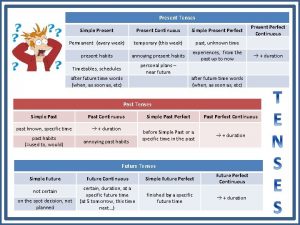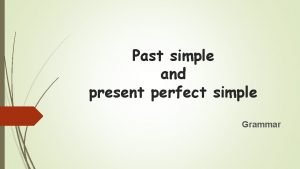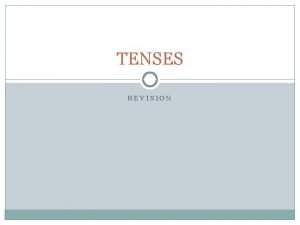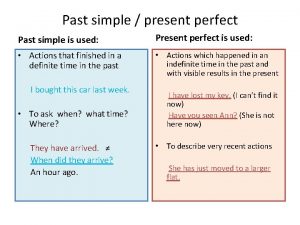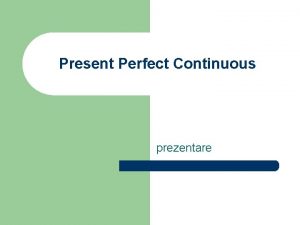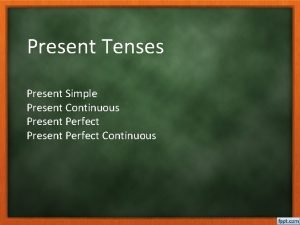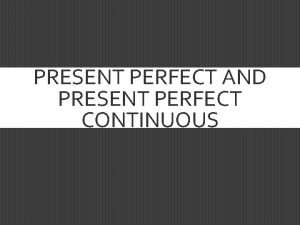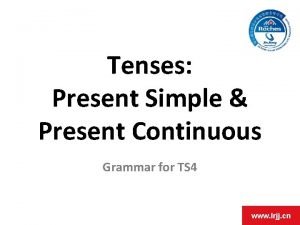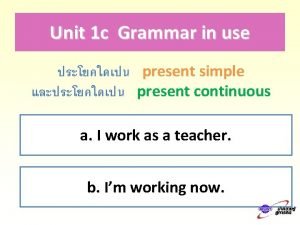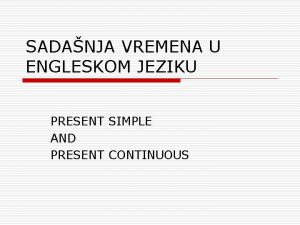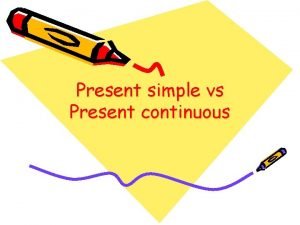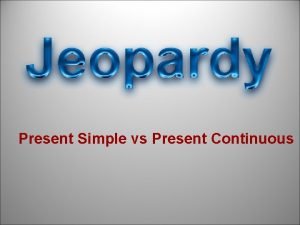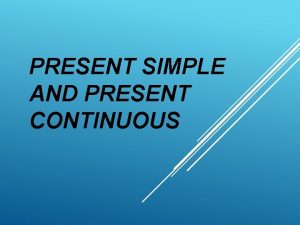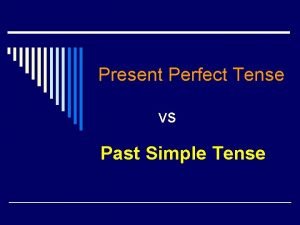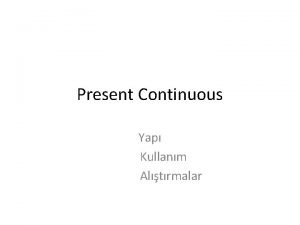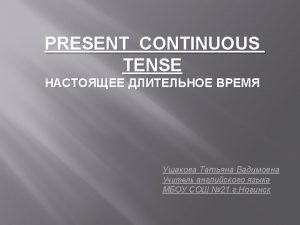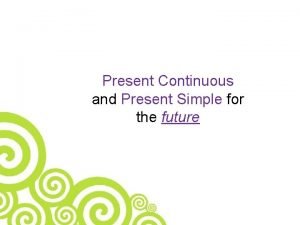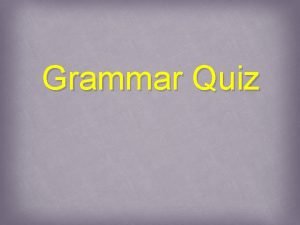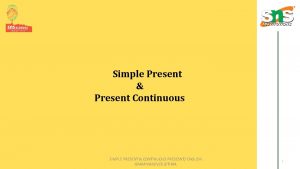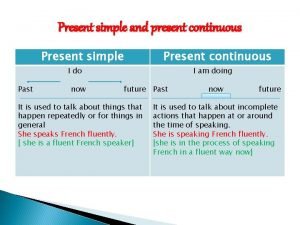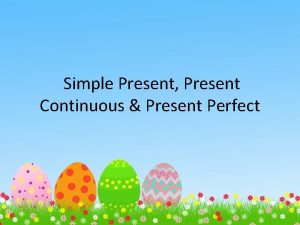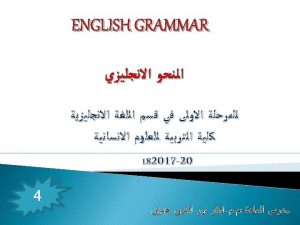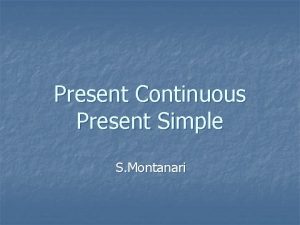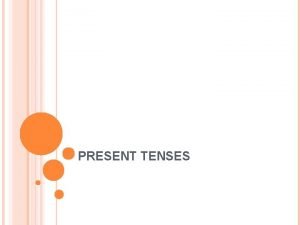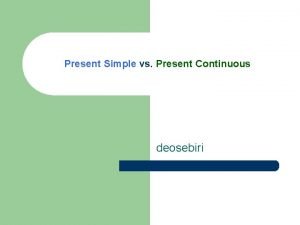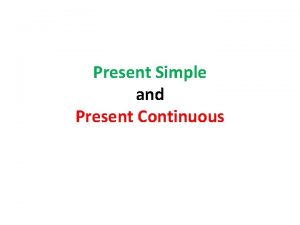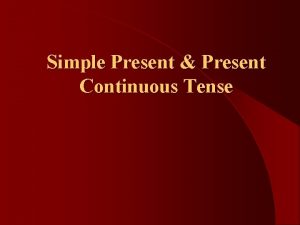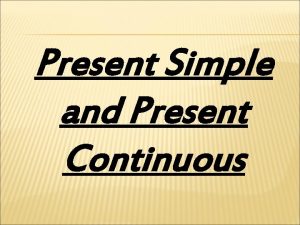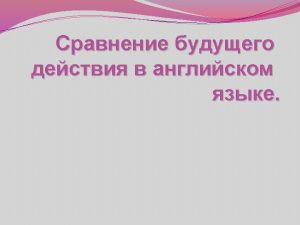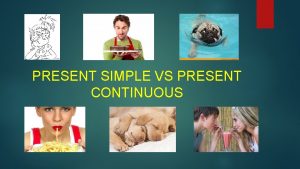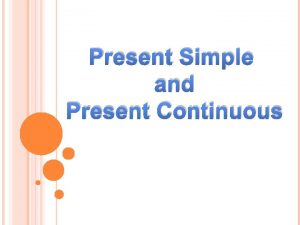ENGLISH LANGUAGE 4 PRESENT SIMPLE VS CONTINUOUS PRESENT






























- Slides: 30

ENGLISH LANGUAGE 4 PRESENT: SIMPLE VS CONTINUOUS

PRESENT TIME • Present time may be seen as: • More general or permanent time relating to truths and general facts • References to present time are made through simple and continuous form of the present tense • The moment of speaking or writing • The idea of the time around now

PRESENT SIMPLE • The present simple is formed using the present tense form of a lexical verb (the same as the base form) for all persons except the third person singular. • The third person singular is formed by adding – s or – es to the base form.

PRESENT SIMPLE FORMATION Affirmative Negative Interrogative subject + main verb subject + auxiliary do (neg) + main verb auxiliary verb do + subject + main verb? I study You sleep He kicks She listens It runs We smile You go They bring I don't study You don't sleep He doesn’t kick She doesn’t listen It doesn't run We don't smile You don't go They don't bring Do I study? Do you sleep? Does he kick? Does she listen? Does it run? Do we smile? Do you go? Do they bring?

SPELLING AND PRONUNCIATION • To form the affirmative form we use the infinitive without to (ski) and to form the 3 rd person singular in the affirmative form we add -s but: • - vowel + y: - add s (annoy, delay, employ play, stay) • - consonant + y: y turns to - i and then add es (apply, merry, worry, carry, rely, cry, fly, study, supply, spy) • - o, s, ss, z, ch, sh, or x: -es - add es (go, do, focus, miss, pass, buzz, match, watch, push, rush, box)

PRESENT SIMPLE - USAGE • The present Simple is used: • To describe permanent situations Tina lives in Sheffield. John has got three children. Marry works at the Post Office. He is a PE teacher.

PRESENT SIMPLE - USAGE • To describe repeated/habitual actions. • A frequency adverb is often used - always, sometimes, usually, often, never… Where do you usually go at the weekends? Monica doesn’t play chess every day. Michael sometimes runs at Ada. Students come to their English lectures every Wednesday evening.

PRESENT SIMPLE - USAGE • To talk about general truths and facts The Sun is a star at the center of our Solar System. Plants give us oxygen. Pluto is not a planet. Water boils at 100˚C.

PRESENT SIMPLE - USAGE • Summary of events in a narrative for historical events, or for example in a book or a film. In 1789 the French revolution begins. She comes home and finds the door unlocked. The first scene shows winter in the park.

PRESENT SIMPLE - USAGE • To talk about future actions related to timetables and programmes We leave for Italy next week. The plane takes off at 4 p. m. The football match starts at 20. 45 p. m. UEFA Champions League finals is on 12 th of May.

PRESENT SIMPLE - USAGE • In exclamatory sentences with Off …/ Here …/There …// etc. Here she comes. There they are. Off you go.

PRESENT SIMPLE – TIME EXPRESSIONS • • Every day/week/year… In the morning/afternoon/spring/autumn. . . At the weekend/weekends Once/twice/three times etc. A week/day/month… • On Monday/Mondays/Tuesday morning…

PRESENT CONTINUOUS • With present continuous the focus is principally on the duration of the event. • It may therefore be used to indicate that something is ongoing, unfinished, or that it is extended but temporary • It may indicate that something is happening while something else is happening at the same time

PRESENT CONTINUOUS FORMATION Affirmative Negative Interrogative subject + auxiliary verb to to be + verb-ing be (neg) + verb-ing auxiliary verb to be + subject + verb-ing? I am laughing You are sitting He is thinking She is dribbling It is sleeping We are cheering You are heading They are scoring Am I laughing? Are you sitting? Is he thinking? Is she dribbling? Is it sleeping? Are we cheering? Are you heading? Are they scoring? I’m not laughing You aren’t sitting He isn’t thinking She isn’t dribbling It isn’t sleeping We aren’t cheering You aren’t heading They aren’t scoring

SPELLING AND PRONUNCIATION • CVC rule: If the verb ends in a consonant-vowelconsonant when the stress is on the last syllable then the last consonant is doubled. put – putting, stop – stopping, run – running, begin – beginning, regret – regretting, forget – forgetting, sit – sitting, swim – swimming…

SPELLING AND PRONUNCIATION • We don’t double up the final consonant when it is w, x, or y. Play – playing, box – boxing, flow – flowing, study – studying… • If the verb ends in letter –e then erase it and add –ing Make – making, bake – baking, have – having, shave – shaving…

SPELLING AND PRONUNCIATION • If the verb ends in –IE we change it to – YING To lie – lying To die – dying To tie - tying

PRESENT CONTINUOUS - USAGE • An ongoing process at the moment of speaking Robert is talking to his boss at the moment. The crowd is cheering loudly and the atmosphere at the statium is absolutely fantastic. The competitors are running towards the finish line.

PRESENT CONTINUOUS - USAGE • To describe temporary situations which are not yet finished I’m staying with my aunt at the moment. He is currently playing for Chelsea. Stacey is working at her family’s restaurant at the moment because her sister is ill. Randy is presently living in Sydney.

PRESENT CONTINUOUS - USAGE • To describe situations which are changing or developing around the present time Air pollution is increasing in our city. My grandparents are getting old. The midfielder is recuperating from a knee injury. I’m getting better and better at speaking English.

PRESENT CONTINUOUS - USAGE • To talk about future arrangements I’m visiting some friends at the weekend. We are playing volleyball at 4 p. m. Mark is moving to New York tomorrow.

PRESENT CONTINUOUS - USAGE • A repeated temporary situation • A time expression is necessary • This is particularly true when always is used – in examples like these we are usually complaining or exaggerating They are making the same mistake again! You’re always borrowing money from me. He is always losing his keys.

TIME EXPRESSIONS • Now, at the moment, at present, today, these days • This week/year • Next week/year • Tonight, tomorrow • Etc.

STATIVE VERBS • Some verbs are not normally used in the continuous form, because they describe activities which already extend in time. • These are called “state verbs” Be, believe, depend, cost, have, hear, know, matter, smell, suppose, taste, think, understand

STATIVE VERBS • Verbs of the senses: see, feel, hear, smell, taste, notice, seem, appear, look… • Verbs of emotions: like, love, hate, dislike, want, need, prefer, mind… • Verbs of perception and opinion: know, agree, find, think, believe, understand, remember, forget, hope, mean… • Other verbs: be, have, own, belong…

STATIVE VERBS • Some of these verbs can be used in continuous forms with a change of meaning. Tim is being rather difficult at the moment. I’m having breakfast. I’m tasting the soup, to check if it needs more salt. I’m thinking of buying a car.

PRESENT SIMPLE VS PRESENT CONTINUOUS • In many situations we can use either simple or continuous form. The simple form is for a permanent situation and the continuous form is for temporary situation. I live in London. (It’s my permanent state) I’m living in London. (just for now, my home is Athens)

PRESENT SIMPLE VS PRESENT CONTINUOUS • In many situations we can use either simple or continuous form. The simple form is for a permanent situation and the continuous form is for temporary situation. Do you sleep a lot? (Is it your habit? ) Are you sleeping enough? (What is happening at the moment? )

BIBLIOGRAPHY • • • R. Carter, M. Mc. Carthy (2006), Cambridge Grammar of English, A Comprehensive Guide, Spoken and Written English Grammar and Usage, Cambridge University Press R. Murphy (2004), English Grammar in Use, A self-study reference and practice book of intermediate students of English, Cambridge University Press H. Q. Michael, M. Malkogianni (2016), Pioneer, MM Publications

THE END • Thank you
 Study present continuous
Study present continuous Simple past simple present simple future
Simple past simple present simple future Present simple past simple future simple
Present simple past simple future simple Have present simple
Have present simple Present continuous vs future simple exercises
Present continuous vs future simple exercises Past perfect simple past perfect continuous
Past perfect simple past perfect continuous If tenses
If tenses Present continuous signaalwoorden
Present continuous signaalwoorden Present simple function
Present simple function Present simple present continuous past simple
Present simple present continuous past simple Past present simple
Past present simple What is past future continuous tense
What is past future continuous tense Present perfect present simple present continuous
Present perfect present simple present continuous Present simple present continuous present perfect
Present simple present continuous present perfect Present perfect simple schema
Present perfect simple schema Present simple present continuous present perfect
Present simple present continuous present perfect Present simple present continuous and present perfect
Present simple present continuous and present perfect Present continuousگرامر
Present continuousگرامر 1 c grammar in use
1 c grammar in use Present simple i present continuous razlika
Present simple i present continuous razlika Present simple and present continuous form
Present simple and present continuous form Simple present or present progressive
Simple present or present progressive Present simple vs present continuous powerpoint
Present simple vs present continuous powerpoint Look at that kangaroo it is carrying its baby
Look at that kangaroo it is carrying its baby Present simple present continuous
Present simple present continuous Present perfect tense examples in hindi
Present perfect tense examples in hindi Past continuous tense alıştırmalar
Past continuous tense alıştırmalar I read a book present continuous tense
I read a book present continuous tense Present continuous used for
Present continuous used for Past simple past continuous present perfect
Past simple past continuous present perfect Grammar quiz present simple เฉลย
Grammar quiz present simple เฉลย






